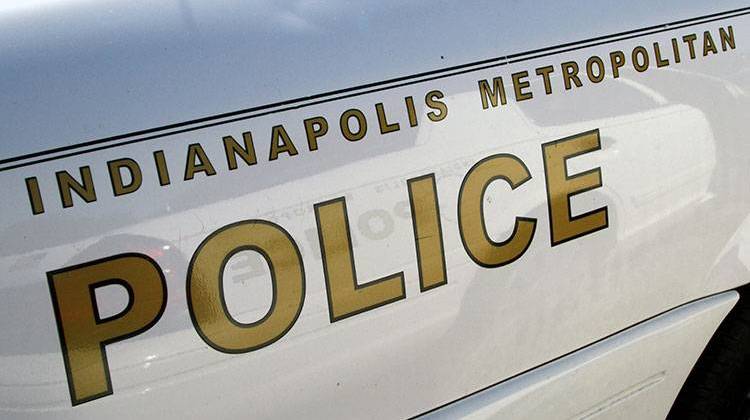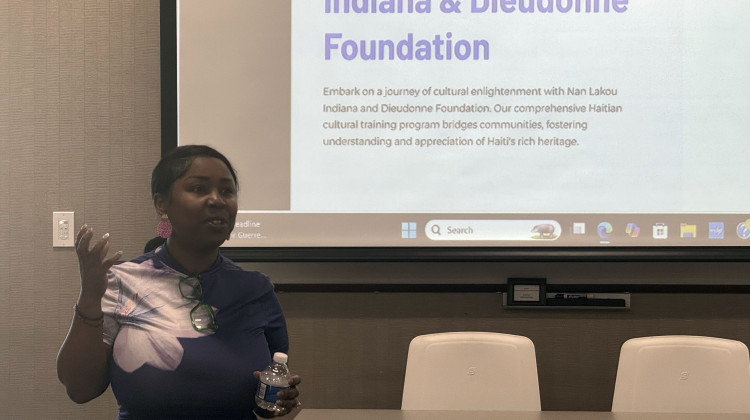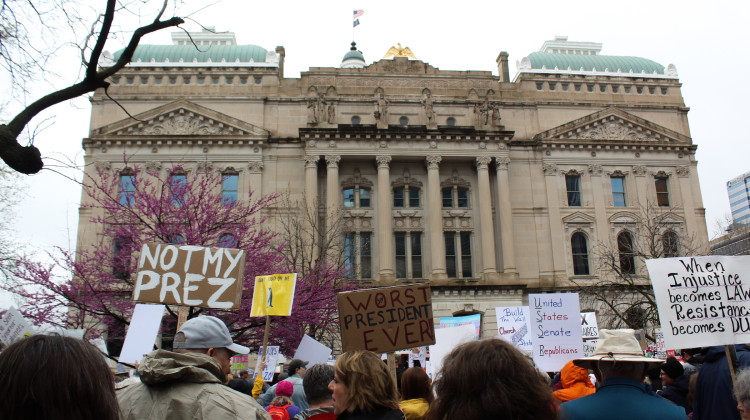
A fence stands in front of the rubble of buildings that were once part of the Indiana Women's Prison on Indianapolis’ Near east side
Jill Sheridan/WFYIThe Indiana Women's Prison site on Indianapolis’ east side is a large property ripe for redevelopment. Community members are excited by future prospects, but they say a lack of communication with the state – which owns the property – is discouraging. With no word on plans, it’s not clear what will happen to the site of the first public prison for women.
A creek flows under the Woodruff Place Baptist Church. It helps cool the early 1900’s building on the Near Eastside of Indianapolis. Residents have discovered the creek also flows through another historical site just a few blocks away: the now abandoned Indiana Women’s Prison.
When the wrecking crews showed up and buildings started coming down, residents had questions.
“Are they going to tear down all the buildings? Are they going to tear down some of the buildings?” Newsom said. “And then as the demolition continued, the place – the whole property – became more and more ransacked.”
Joey Newsom lives across the street from the old prison and is part of an advocacy group trying to engage the state in discussions about the future of the 15 acre site. The property is owned by the state of Indiana after nearly 140 years as a prison.
A recent meeting was one of the first for community members excited about the future of the Women’s Prison site. Melissa Benton is one of those neighbors.
“You can't deny the fact that having a prison in the middle of this urban neighborhood has been a barrier to redevelopment, and that we really strongly believe that the people who have stayed here, and lived through that, deserve to have a say in what the next iteration of this is – particularly if it's going to improve the quality of life,” Benton said.

Meaningful, strategic redevelopment can improve quality of life, especially for disinvested neighborhoods like the Near Eastside. Development can close food gaps, bring needed jobs and increase affordable housing. Benton said she knows it’s been done and points to another project right down the street.
“The Sherman Park site,” Benton said, “they came to the neighborhood and said, ‘We want to put this criminal justice campus here. What do you guys think?'”
The community decided against that plan, and the redevelopment that’s moving forward touches a variety of neighborhood needs.
The state has hired a community engagement consultant, but many community members doubt whether thoughtful engagement will really happen – or if the outreach is just another box to be checked off.
“We're the ones that are impacted by what happens at the site. What's happening now with the way the building is what's going to happen in the future, not the state, right? The state doesn't live here,” Benton said. “But nobody's listening to us.”
More than a century of history
Benton has a personal interest in the site. She was formerly incarcerated at the Women’s Prison. So was Michelle Daniel Jones. Jones helped rehab, build and maintain spaces for the community. She had many ideas for reuse, but now several buildings are mountains of rubble. Jones said it seems nothing special will be done to remember the significance of the site that was home to the nation’s first women's prison.
“I think about all of the women who were incarcerated in that place from 1873 to when we left in 2010,” Jones said. “I feel deeply that we should have some consideration of what possibly becomes of that space, because that land is soaked with the labor, blood, sweat, and tears of thousands of women.”
Jones said the women had a history of work progress at the prison. Community projects included restoration of the chapel built in the 1930's.
“The women did all that labor to rehabilitate that building. Just like the women did all the work to, you know, to outfit the industrial building now that sits in rubble over there,” Jones said.

Identifying priorities
The entire Near Eastside is undergoing rapid change. With that change is a tug of war between community wants and economic demands.
A consultant for the state has said there will be a request for ideas, but that hasn’t happened yet. They could also just sell the site and be done with it.
What many neighbors do not want to see is $500,000 condos, which can add to gentrification and displacement.
Recently, the advocacy groups presented a list of priorities to the state Department of Administrations, which has control of the site. The list of suggested priorities includes recognition of the site’s importance, the development of a community-backed master plan, and securing the site so possible historic preservation doesn’t become a moot point.
The prison site is in City-County Councillor Zach Adamson’s district. He’s tried to meet with state officials to discuss the site to no avail.
“It’s in a neighborhood that they have really sort of abandoned a long time ago, but this is our home,” he said.
Adamson urged community members to continue to work for what they want, but understands the frustration of feeling like no one is listening.
“They take the talking points that the community gives, and they give them back to the state. What they do with them after that – they probably go right into the garbage. We have no idea,” Adamson said.
He said the community engagement piece can work to improve the neighborhood and the city.
“But that should have happened over the last two years. And if we don't have a state use for this property now, there doesn't exist one,” he said. “But we shouldn't be trying to create a state use, just to avoid letting progressive development in this area.”
The Department of Administration says it has communicated with members of the neighborhood and listened to the concerns regarding clean-up of the site. Demolition for the rest of the buildings is on hold for now.
Contact WFYI city government and policy reporter Jill Sheridan at jsheridan@wfyi.org. Follow on Twitter: @JillASheridan.
 DONATE
DONATE






 Support WFYI. We can't do it without you.
Support WFYI. We can't do it without you.